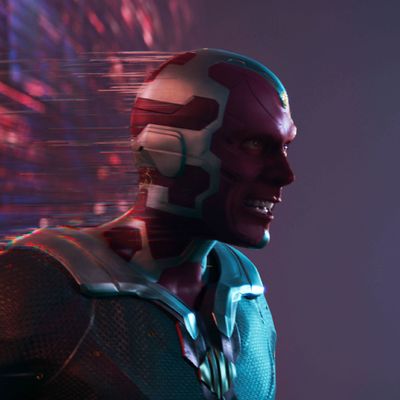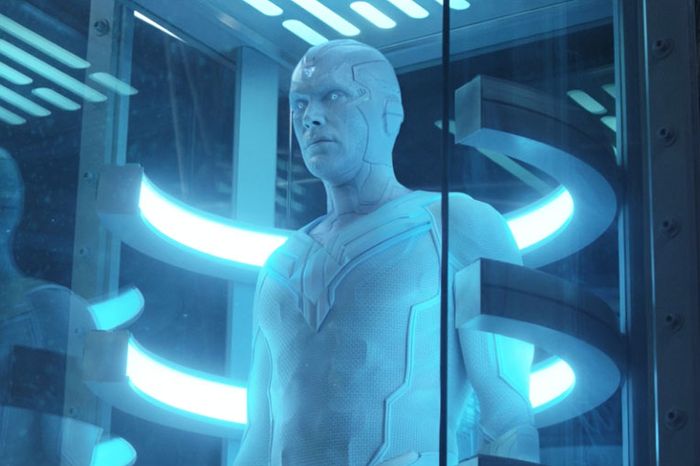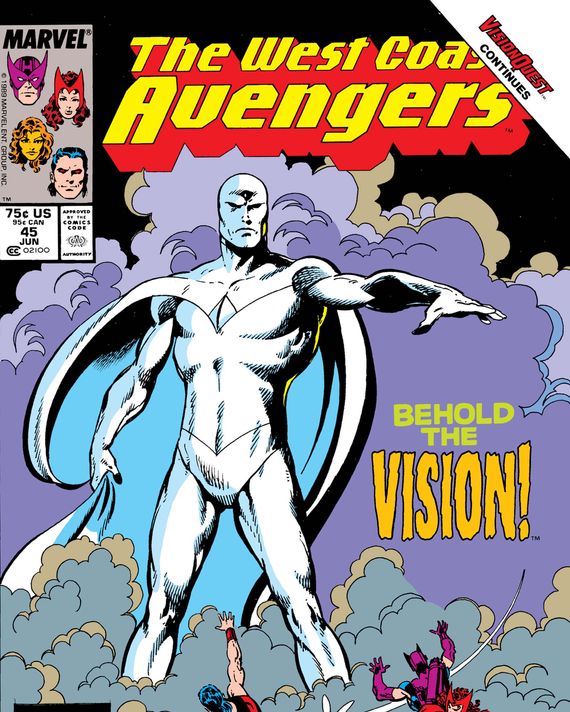
Caution: Spoilers ahead for the ending reveal of episode 8 of WandaVision.
One of the more interesting things about watching new Marvel Comics adaptations hit the screen is seeing how they remix elements of classic comic stories in fresh new ways. The MCU’s first series for Disney+, Wandavision, hasn’t disappointed in that regard, whether playing with the franchising shenanigans of multiple Quicksilver castings or introducing the young (and then quickly not so young) twins Billy and Tommy.
Episode eight’s mid-credits scene was no different. At the very end of “Previously On,” viewers were treated to the sight of what appeared to be Vision’s reassembled original body, now pure white, as it was activated by S.W.O.R.D. director Tyler Hayward. This form of Vision has a comics history of its own, as a creation by John Byrne meant to specifically distance the character from his relationship with Wanda; there, it was the result of a disassembly, complete with his original programming being erased. When he was restored shortly after, it was without the emotional components copied from fellow Avenger Wonder Man, resulting in a colder, more robotic personality.


It was a somewhat misogynistic story line, one that heaped trauma and mental instability upon Wanda, forcing her to endure the loss of her children and her husband, followed by the reveal that those things had never been real to begin with but rather illusions born of her desires. Vision would eventually be restored to his normal form, but the damage was done, and so was his relationship with Wanda. He went back to being a regular superhero, while Wanda was demonized for her struggles with mental health, written as a sobbing, hysterical stereotype who committed progressively horrific crimes as the years passed.
The Marvel Cinematic Universe has already started to adapt that aspect of her character, what with the events of Captain America: Civil War and Wanda’s subsequent house arrest, followed by a turn as a fugitive. It’s hard to say where character arcs will go once the series concludes, but WandaVision, at least, seems to be putting work into giving Wanda a sense of agency. Make no mistake, her usurpation of the lives of Westview’s residents is still an act to be condemned, but it’s a far cry from some of the atrocities her comic-book counterpart has been responsible for. Additionally, while it’s true that she’s still created illusory children, she’s aware of this. That’s a significant point; no longer are these simply things happening to her; they’re manifested extensions of her attempts to process an immense amount of grief. Similarly, what seemed early in the season to be a violation of Vision’s explicit wishes upon his death turned out not to be the case; as “Previously On” confirms, the Vision that exists inside of her hex bubble around Westview is born entirely of her memory and power, created from thin air.
This manipulation of the classic story involving the Vision’s reassembly and reactivation is perhaps the most fascinating thing the show has done so far. It seems, almost, to flip the entire concept on its head; instead of creating a Vision without a personality specifically to separate the couple, WandaVision has now given us Vision’s repaired and reactivated body, as well as a fully intact Vision personality. It’s hard to say what will happen when the two meet, as it raises a multitude of questions.
For instance: We know from Vision’s futile attempt to break out in “All-New Halloween Spooktacular!” that Wanda’s creations can’t exist outside her hex bubble, but what if one of those creations is given a corporeal form from outside the bubble to inhabit? If that becomes possible, then what does it mean for the couple’s twins? Given the enormous amount of power Wanda is expending in order to maintain this bubble (and the way it’s clearly fraying as a result), is it possible she could narrow her focus to just the twins in this week’s final episode? Granted, it would be a heretofore unseen level of ability in the MCU (outside the use of the Infinity Gauntlet, anyway), but given that she’s already doing that inside of a bubble, there’s no reason given thus far that a narrower focus wouldn’t result in a much more stable, long-term outcome.
As previously mentioned, the casting of several Young Avengers characters across various Marvel movies and shows indicates that Disney may be planning a franchise centered on them as a team in the future. In the comics, Billy and Tommy were early members of that team. Could it be possible that the ultimate purpose of WandaVision is to not only restore Vision to life but to introduce another pair of new, young heroes for the MCU? It’ll certainly be fun to find out.

